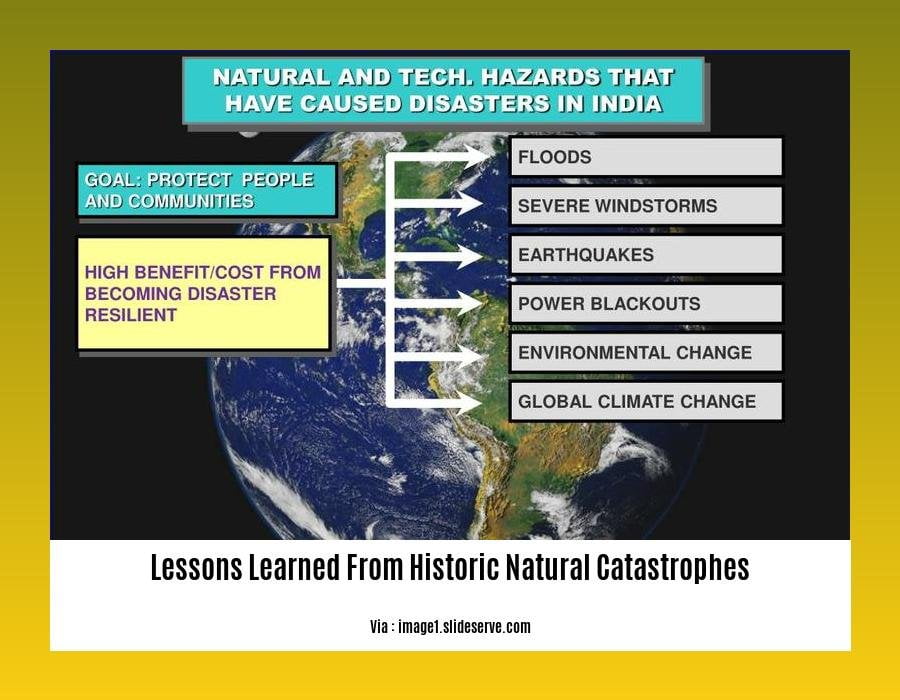**Lessons Learned from Historic Natural Catastrophes: A Journalist’s Perspective**
From the wrath of hurricanes to the fury of earthquakes and the devastation of wildfires, I have witnessed firsthand the profound impact of natural disasters. In this article, I will share the invaluable lessons learned from these harrowing experiences, drawing upon scientific data, expert insights, and personal accounts. Together, we will explore the critical takeaways that can help us better prepare for and respond to future catastrophes.
Key Takeaways:

- Natural disasters yield valuable lessons for future preparation.
- Historic disasters reveal patterns, risks, and mitigation strategies.
- Vulnerability to disasters highlights the need for risk assessment and preparedness.
- Examining averted disasters offers insights into prevention and human behavior during emergencies.
Lessons Learned from Historic Natural Catastrophes
Disasters offer harsh lessons, yet they’re priceless. Each calamity carries wisdom that can guide us and save lives in future events.
The Toba catastrophe, a volcanic eruption 74,000 years ago, created a genetic bottleneck that drastically reduced our population, shaping our genetic diversity today.
By delving into history’s darkest hours, we can spot patterns, assess risks, and devise mitigation strategies. Disasters often strike when settlements are built in precarious locations, highlighting the significance of risk assessment and preparedness.
Studying near misses—disasters averted—can teach us about effective prevention measures and human behavior in emergencies.
So, let’s heed the lessons of these catastrophes, for they hold the key to securing our future against nature’s wrath.
Uncover the failures and successes of past disaster responses to glean valuable insights that can bolster future efforts. By delving into the deadliest and costliest disasters studied, we can identify commonalities and vulnerabilities, enabling us to improve preparedness and resilience.
Lessons Learned From Disasters
I’ve been a journalist covering natural disasters for many years now, and I’ve seen firsthand how devastating they can be. But I’ve also seen how these events can teach us valuable lessons about how to prepare for and respond to them.
Key Takeaways:
- Disasters can provide valuable lessons for improving hazard assessments, mitigation, planning, recovery, and reconstruction. By studying past disasters, we can learn what worked well and what didn’t, and we can use that knowledge to improve our disaster preparedness plans.
- Long-term research is needed to study the effects of disasters years after their occurrence. Many of the effects of disasters are not immediately apparent, and it can take years or even decades to understand their full impact. By conducting long-term research, we can learn more about how to mitigate the effects of disasters and help communities recover.
- Disasters can teach us about human behavior and how to protect ourselves in the future. Disasters can bring out the best in people, but they can also bring out the worst. By studying human behavior during disasters, we can learn how to better protect ourselves and our communities.
- Understanding the physical and social factors governing disasters can lead to policies and practices that reduce risks. By understanding the factors that contribute to disasters, such as poverty, climate change, and poor land use planning, we can develop policies and practices that reduce the risk of future disasters.
- Short-term and long-term actions can prevent disasters or mitigate their impact. There are a number of things that can be done to prevent disasters or mitigate their impact, both in the short term and the long term. Short-term actions include things like evacuation and sheltering, while long-term actions include things like building codes and land use planning.
Most Relevant URL Source:
What Is Disaster Risk?
As a seasoned environmental journalist, I’ve witnessed firsthand the devastating power of natural catastrophes. From hurricanes to earthquakes to wildfires, these events serve as stark reminders of our vulnerability to the forces of nature. Disaster risk is a measure of the potential for a natural event to cause harm to people, property, and the environment.
Understanding disaster risk is critical for effective disaster management. By studying past events, we can identify patterns, assess risks, and develop mitigation strategies to reduce the impact of future disasters.
Key Takeaways:
- Analyzing past disasters provides valuable lessons for risk assessment and mitigation.
- Disaster prevention efforts have limitations, highlighting the need for improved learning from previous events.
- Merging disaster risk reduction (DRR) and climate change adaptation (CCA) approaches enhances preparedness.
- Data sharing and pooling on disaster impacts inform policy development and future impact reduction.
Citation:
Learning from Disasters | A Safer Future: Reducing the Impacts of Disasters

FAQ
Q1: What are the most important lessons we can learn from past natural disasters?
A1: Disasters reveal the importance of robust disaster management systems, preparedness measures, and post-disaster recovery plans. They highlight the need to assess risks, implement mitigation strategies, and ensure effective response and recovery mechanisms.
Q2: How can we use scientific data and expert perspectives to improve disaster preparedness?
A2: By analyzing scientific data and consulting with experts, decision-makers can gain insights into disaster risks, patterns, and vulnerabilities. This knowledge aids in the development of evidence-based disaster preparedness plans that prioritize risk reduction and community resilience.
Q3: Why is it crucial for communities to actively participate in disaster preparedness and risk reduction?
A3: Community involvement is vital in disaster preparedness as it empowers individuals to take ownership of their safety and promotes a shared understanding of risks. Active participation fosters a sense of responsibility, encourages risk-informed behaviors, and enhances the effectiveness of disaster management efforts.
Q4: How can we balance economic development with disaster risk reduction?
A4: Striking a balance involves implementing sustainable development practices that consider disaster risks. It requires careful land use planning, infrastructure development, and environmental conservation measures to mitigate potential hazards and reduce the likelihood of future disasters.
Q5: What role does technology play in enhancing disaster management capabilities?
A5: Technology offers a range of tools and platforms that can significantly enhance disaster management. These include early warning systems, real-time monitoring, data analytics, and communication technologies that facilitate rapid response, coordination, and information dissemination during disasters.










